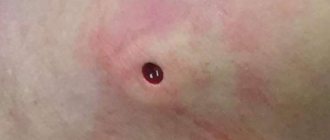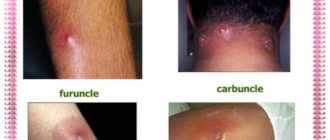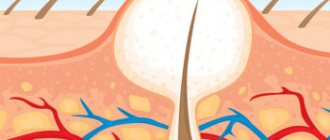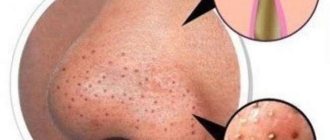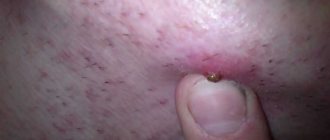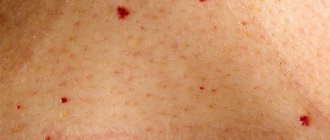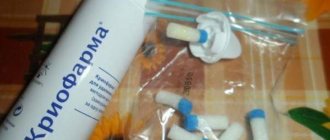Causes of boils
There are several reasons for the appearance of this formation, the main factors are:
- decreased immunity;
- problems with metabolic processes in the body;
- failure of the hormonal system;
- neglect of personal hygiene rules;
- presence of chronic diseases;
- increased sweating;
- poor nutrition.
Stages of boil development
The development of this formation occurs in several successive stages.
- The formation of a dense infiltrate, which has a bright red color, differs from a classic pimple in more severe pain, which can last 3-4 days.
- Purulent-necrotic stage. This stage, which begins at the end of the fourth day of the disease, is accompanied by the formation of a boil core. A “head” protrudes from the affected area.
- Healing. It occurs only after complete extraction of the contents from the cavity of the formation. The duration of this stage is 2-3 days, and in advanced and particularly difficult situations – longer.
Signs of a purulent core coming out
After the boil passes into the necrotic stage, the pus will mature within 5-6 days. Pain, swelling and general intoxication will increase. The skin over the abscess is tense and thinned. If the course is uncomplicated, the abscess on the surface may burst. Rejection of the rod after a breakthrough occurs within 1-3 days. Liquid pus from white to yellow-green color with an unpleasant odor begins to be released. A small amount of blood may be present. Then the root of the boil appears. After opening the boil, the pain decreases, the temperature drops, and the symptoms of intoxication weaken. Hyperemia and swelling become less. After rejection, the wound surface becomes covered with granulations and heals.
What to do to remove the core of a boil at home
Removal of this ugly abscess, which causes discomfort, can be done at home independently. Doctors recommend starting to use stretching ointments, which are made at home or purchased at a pharmacy. Next you need to start removing the pus.
At first glance, the process seems complicated and difficult, but in reality it is not.
- The event can only be carried out if the abscess is fully mature. Signs of maturation are a formed rod, a “head” rising above the abscess, a yellowish color of the formation.
- Take alcohol and cotton wool and disinfect the abscess. Using the same product, treat your hands or wear gloves to prevent infection from entering a fresh wound.
- Using two fingers, press on the edges of the chiri in the place where the redness ends. From the edges you need to move slowly towards the central part. It is forbidden to use nails; the procedure is carried out strictly using the fingertips.
- Remove the released mass with a cotton swab. The fact that the pustular formation has been completely removed will be indicated by protruding blood and a hole after the rod.
- Carefully inspect the released exudate. It should contain not only liquid pus, but also a core. If this does not happen, there is a possibility that the inflammatory process will continue.
- When you are sure that the entire boil has come out, you need to wash the wound using hydrogen peroxide, which will destroy all remaining bacteria. Calendula ointment is applied over the wound, and the area is temporarily covered with a bandage.
If the pimple is 100% ripe, squeezing it out will not be difficult.
Important to know! You need to make sure that there are no remaining parts of the pimple - purulent mass, elements of the stem, otherwise the inflammatory process will continue to develop.
If any changes or complications appear after removal, this is a clear reason to contact your treating specialist.
Danger and possible complications
In no case should we forget that a boil is not just a harmless pimple, albeit a large one.
The disease may be complicated by the development of:
- furunculosis,
- carbuncles,
- abscesses,
- meningitis,
- arachnoiditis,
- thrombosis of the cavernous sinus,
- phlebitis,
- sepsis,
- lymphangitis,
- phlegmon,
- pyelonephritis, etc.
In most cases, inflammation of a small boil does not cause serious problems. However, large structures can lead to blood poisoning and sepsis. Treating boils at home is fraught with additional complications and disorders. Complications are expected based on the location of the boil:
- The facial area (ear, nose, lips) is a dangerous place; infections through the blood vessels quickly reach the cerebral cortex, encephalitis, capillary dysfunction, and meningitis develop. A patient with such ailments experiences nausea, vomiting, and headaches. After 12 hours, elevated body temperature and partial paralysis of the limbs are observed.
- Development of carbuncles. The disease becomes more complicated due to a weakened immune system. A common location is the buttocks. Serious reasons for hospitalization.
- Blood poisoning due to staphylococcal formations. If left untreated, the pathology results in 100% death. Sepsis is accompanied by elevated temperature and severe weakness of the body.
- Ulcerative stage scarring. The maturation of the rod provokes the rejection of purulent residues from the skin. Over time, the ulcer forms in the form of a crater. The affected area/point becomes scarred. The area looks ugly.
DETAILS: Vitamins for gums with periodontitis
What are the signs of proper boil removal?
People encountering the disease for the first time should know what an abscess looks like, how to remove it, and what should be left after it. Here are some key signs that you did everything right:
- there is a gradual decrease in swelling around the wound;
- the purulent root has jumped out, and when palpating the pimple, no seals are observed;
- after squeezing out all the contents, a reddish liquid mixed with blood begins to flow from the wound;
- after 2-3 days, the tubercle decreases in size, and the redness and pain go away.
This often leaves a scar. If problems make themselves felt in the groin area, on the face or neck, you should definitely contact a surgeon, since independent actions are fraught with negative consequences.
Drug therapy
Among pharmaceutical preparations, Vishnevsky ointment, ichthyol ointment, and external medications based on syntomycin and streptocide are widely used. These compounds relieve inflammatory symptoms and reduce pain by drawing out pus. In especially dangerous situations, antibiotics are prescribed - penicillin, ampicillin, amoxicillin, tetracycline, gentamicin.
Their use occurs in the form of a compress. A small amount of the composition is squeezed onto a cotton pad, then it is applied to the wound and fixed with a bandage or bactericidal patch. To prevent the abscess, when it ruptures on its own, from staining clothes, shoes, and bed linen, it is recommended to constantly apply gauze bandages to it. This will allow the wound to close and the pus to drain onto the dressing material.
Surgical removal of the rod
At first, the developing disease may be confused with an ordinary pimple, but it quickly begins to grow, break out and become very painful. This forces many patients to consult a dermatologist. At the first stage, the doctor only observes the disease and prescribes internal and external treatments. If necessary, he can prescribe an operation and open the abscess to allow the pus to come out. Rehabilitation plays an important role, because the outcome of treatment depends on the correctness of the procedures carried out at this stage. The patient must periodically treat the wound with medications prescribed by the doctor and regularly change the dressing.
Traditional medicine recipes
The following folk recipes will help relieve the symptoms of the disease and eliminate inflammation.
- Aloe. The pulp of this plant is taken, cleared of the dense crust, and then applied to the abscess and secured with a bandage or adhesive plaster. The compress must be changed every few hours.
- Golden mustache. The leaves of the plant are finely chopped and then applied to the abscess in the form of a paste. From above, all this is covered with a gauze bandage. The change is carried out at the same frequency as in the previous recipe.
- A mixture of onions and garlic. Take a clove of garlic and several layers of onion, grind it all to a pulp and dilute with 1 tbsp. l. vegetable oil. The mixture is used as a compress, which must be applied regularly to the formation.
The treatment seems simple, and when applied, the abscess matures in just 4-7 days. Sometimes, after using folk recipes, the boil opened on its own. After this, treatment should be stopped and hydrogen peroxide should be used to treat the wound.
Medications that accelerate the maturation process
In the treatment of pustular skin lesions, local therapy takes a leading place. When a boil bursts, the following medications are recommended:
| Detoxification and adsorbing solutions | Hypertonic sodium chloride 0.9% and 10% |
| Alcohol solutions of aniline dyes |
|
| Disinfectant pastes |
|
| Anti-inflammatory ointment forms |
|
| Antimicrobial ointments |
|
| Proteolytic enzymes | |
| Tissue regeneration stimulators in the form of ointments |
Local therapy is carried out for any form of the disease when a boil opens, regardless of the patient’s age. Its main tasks are:
- complete cleaning of the resulting cavity from purulent-necrotic masses;
- relapse prevention;
- acceleration of healing;
- preventing the development of complications.
A big advantage of local exposure is the small number of side effects due to minimal absorption of drugs into the bloodstream. This is important when selecting therapy for children.
Systemic medications are indicated for burst boils in 4 cases:
Both medications sold in pharmacies and folk remedies can help chiria ripen faster. When using the former, you should follow the instructions and not exceed the dosage.
When using grandma’s recipes, you should be careful and if your condition worsens, immediately stop using them. Before each procedure, regardless of what treatment method the patient resorted to, inflammation should be treated with a solution of hydrogen peroxide.
Use a moistened cotton swab to wipe the boil from the edges to the middle. To help it mature faster, the patient can use medical remedies, such as:
Most often, certain pharmaceutical ointments are used to treat boils.
Ways to prevent disease
So that furunculosis does not bother you and the inflammatory process does not occur, you must adhere to the simplest preventive measures.
- Follow the rules of personal hygiene. Wash your face and hands with soap after coming from outside, going to the toilet, or contacting animals. Wash yourself regularly.
- Use only clean clothes, underwear and bed linen. Ironing is another important stage, because under the influence of high temperatures all microbes are destroyed.
- Boost your immunity regularly. Sports, training, walks in the fresh air - all this helps to make the body strong and the body resilient.
- Eat right. Provide your diet with vegetables and fruits. Avoid unhealthy foods. If necessary, take vitamin supplements in addition to food.
- To avoid secondary damage, when removing the growth, make sure that the root is completely pulled out. Otherwise, there is a risk of relapse.
Thus, it is best for the abscess to burst on its own and its entire “composition” to break out, leaving behind only a wound. To avoid complications, including death, it is worth considering that it is better to entrust the autopsy procedure to a specialist.
At the second stage of the disease, a purulent-necrotic boil core forms. After this stage is completed, a white abscess is visible on the surface of the boil, which rises significantly above the surface of the skin. There is a red inflammatory halo around it.
After the abscess matures, it breaks through and all the contents come out. The core of the boil is also removed independently, after which the wound begins to gradually heal. However, there may be cases when pus comes out of the boil, but the rod does not.
Useful video
See more about removing the boil stem in the video below:
The core of the boil is one of its elements. It appears at the second, purulent-necrotic stage of this disease. When it is completed, an abscess forms on the skin surface. The pus located inside this formation, similar to a greenish-yellow “column,” is called a core. It is an object consisting of inflamed cells, sebaceous gland secretions, epithelium and bacterial elements.
What to do if the core does not come out of the boil?
The abscess can be removed independently at home, without the help of a surgeon. To speed up the process of abscess maturation, special ointments are required. It is important to adhere to a strict algorithm of actions:
- Disinfect the abscess with alcohol; sterile gloves must be used.
- Gently press the edges of the abscess with your fingers.
- Remove the contents of the abscess, along with which the necrotic core should come out, with clean cotton swabs. The abscess should burst, the inflamed tissue turns red.
- The appearance of blood is the first sign that the pus has completely come out, leaving a void in place of the rod. If the boil has opened, but the rod does not come out, there is a risk of re-inflammation.
- Be sure to apply Levomekol ointment to the wound.
- Once the boil has completely come out, wash the wound with plenty of hydrogen peroxide. Perform this treatment every 4 hours.
Means for the treatment of furunculosis
You can speed up the maturation of a boil with the help of ointments. They relieve inflammation and swelling of soft tissues, thereby reducing pain, draw out pus and provoke an independent breakthrough of the boil. Adherents of traditional medicine can prepare compresses according to the recipes below. Modern medicine offers a list of ointments that draw out pus, which can be purchased at any pharmacy at an affordable price.
How to remove the stem of a boil at home?
So, what to do if the core of the boil does not come out? When it is not possible to see a doctor, you need to wait for the necrotic masses to clear on their own. If, after opening the boil, the rod does not come out, you can easily remove it, but you need to act very carefully, adhering to the following scheme:
- You will need to prepare cotton wool, a thin and sterile needle, and a 0.05% aqueous solution of chlorhexidine bigluconate.
- The skin is treated with a large amount of solution.
- Using a needle, carefully pry the upper part of the purulent cone and pull it up, but try not to touch the walls of the boil.
- After the rod is completely removed, the wound must be treated with an antiseptic and a sterile bandage is applied.
The greatest danger of self-treatment is that there is a risk of tearing off the top of the rod, when most of it remains inside the boil. As a result, it will take much longer for the remainder of the necrotic mass to come out.
In the most severe cases, when independent actions and the use of antiseptic ointments do not give the desired result, you need to seek help from a surgeon. Immediate surgical intervention will be required to prevent the spread of infection and antibiotics will be prescribed.
Video about pulling pus from a boil:
City Dermatovenerologic Dispensary of St. Petersburg
The boil has opened but the stem does not come out - this means that the inflammatory process in the boil continues. The period of rejection of purulent contents increases, the risk of infection of adjacent tissues, healing with the formation of an extensive scar or the development of complications increases.
Why does a boil break out?
At the initial stage of the disease, a pustule forms at the mouth of the follicle. It contains leukocytes, fibrin clots, and pathogenic flora. With the development of the inflammatory process, staphylococci move, multiply freely and release exotoxins. Infiltration and tissue necrosis form. The affected areas melt, creating pus in the boil.
The body tries to localize the process, forming an infiltration shaft. Under conditions of constant elevated temperature and humidity, staphylococcus continues to multiply in the hair follicle. But the follicle with a boil has strictly defined anatomical dimensions; the shaft restrains the spread of infection to neighboring tissues. The volume of the hair follicle is not enough for a large number of pathogenic organisms. The appearance of a white cone means that the abscess is ripe.
The surface of the skin over the affected follicle is not protected; it becomes thinner under the pressure of purulent formations from the inside. It melts and bursts easily. The opening of the boil occurs. Pus should come out of the formed canal freely. The last part to come off is the necrotic core.
Why is there a blue spot next to the boil stem?
With the development of an abscess, the affected area of the skin acquires a blue, purple tint. The transformation is associated with the loss of the protective properties of the cover. There is pain at the site of the abscess. The wound fills with pus and does not heal. Complex treatment of pathology is inevitable. Blue color indicates tissue necrosis. Over time, the affected area will be replaced by a new epithelial layer.
The development of boils of this color is associated with a number of reasons:
- increased level of sweat production;
- careless shaving of damaged tissues;
- metabolic dysfunction;
- consumption of products of questionable quality;
- decreased protective functions of the immune system;
- hypothermia;
- development of infection due to insect bites.
With large numbers of blue/black ulcers, the formation of headaches will be inevitable. The natural reaction of the human body to the activity of pathogens. Before using antibiotics, it is recommended to conduct a body test. In the case of furunculosis, the level of leukocytes in the blood increases. Single boils are not terrible. The purulent core comes out on its own!
The appearance of a boil is accompanied by a lot of discomfort: pain, swelling and redness greatly affect a person’s quality of life. Treatment of furunculosis can be carried out at home, but in some cases it is impossible to do without a hospital and the help of experienced doctors. This article will be useful to those who are encountering the disease for the first time.
Let us consider in detail what means are most effective to get rid of a boil, how to understand that the boil has completely come out and other nuances of treating a purulent pimple.
What to do when opening a boil
If the boil has broken through, you need to make sure that the hard part - the rod - comes out and cleaning occurs. With an open wound, be sure to follow the rules of antiseptics. It is important to prevent the spread of infection from the opened abscess to adjacent healthy areas of the skin.
Treatment
After the boil has broken through, the purulent liquid masses and the stem that have come out should be removed. This is done using a gauze napkin. It is advisable to work with gloves. Moderate pressure on the area of the opened boil is allowed. This will allow the pus to drain freely.
If blood is released after squeezing, then the wound has been cleaned and the rod has come out. In this case, it is treated with hydrogen peroxide. The drug is applied directly to the opened abscess. Several antiseptic procedures may be required. This will prevent the development of relapse of the disease and prevent the formation of a new rod.
In addition to hydrogen peroxide, the following means can be used to treat a boil after the contents have been released:
- Chlorhexidine;
- Miramistin;
- furatsilin solution;
- Betadine.
If the boil has burst, but the pus or core does not come out
If, after opening the boil, the rod does not come out, you should consult a doctor. He will remove the pus, treat the wound and prescribe further treatment.
If there is no opportunity to get to a medical institution, then bandages with ointments and a hypertonic solution are applied to the boil. This promotes the drainage of purulent contents.
Many experts recommend leaving such a boil alone for several hours. The pain, after the boil has opened, decreases. This promotes natural withdrawal of the rod.
Method for removing the rod after a boil has opened:
- Prepare cotton wool, a sterile needle or tweezers, and an antiseptic solution. This can be hydrogen peroxide, a solution of chlorexedine or miramistin.
- Treat the skin around the opened boil.
- Using a needle or tweezers, grasp the necrotic core that has not come out. Pull it gently. Try not to touch the walls of the wound channel.
- Re-treat the wound with an antiseptic solution. Apply a sterile dressing.
The danger with this method is that the top of the rod is torn off during removal. If this happens, you should not delay contacting a surgeon. It is necessary to prevent the possibility of re-infection and spread of the purulent process.
A similar method is described by users of various forums. But instead of a needle, they suggest using a cotton swab or a disinfected match. The object is inserted into the formed channel and scrolled. The rod must remain on the implement.
The procedure is carried out several times until the purulent masses are completely removed. After the manipulation, blood should come out. After the rod comes out, the wound is washed with an antiseptic and antibiotic ointment is applied.
Contraindications and possible consequences
Squeezing is a very dangerous procedure that has contraindications. It is prohibited to squeeze out a boil in the following cases:
- until the abscess is completely ripe;
- there is a high temperature, pronounced signs of intoxication - very poor general health;
- the inflammatory infiltrate is dense, severe pain is felt;
green pus is visible at the top of the boil;- the abscess has formed too large;
- if it is a repeated abscess, as it may be furunculosis;
- the boil occurred in a child, especially a small one;
- the spread of the boil is very rapid, there is an expansion of redness, swelling, and increased pain;
- old age of the patient;
- the purulent-necrotic core has not formed;
- within several days the boil does not develop (no changes);
- abscesses are located on the face, neck, nose, ears, scalp - the infection can penetrate the blood vessels of the brain and affect its membranes;
Patients with boils in the face and head are treated only in a hospital, since possible complications can result in death. The surgeon performs opening and squeezing out other abscesses in the outpatient clinic.
When performing uncontrolled squeezing of boils at home, you need to be aware of the danger of consequences that can cost your life. After non-medical removal of pus from a boil, the following complications may occur:
- sepsis with damage to the kidneys, liver, meninges;
- expansion of the inflammatory infiltrate if the patient squeezes out a boil with an immature purulent core;
infection of other parts of the body and people present if the procedure is performed incorrectly;- formation of fistulas;
- boil recurrence;
- the occurrence of abscesses with a malignant course (in the area of the nasolabial triangle, on the nose and chin).
It is difficult to talk about the effectiveness of home squeezing out a boil, even if it ended successfully. Any self-medication is dangerous and, most often, not justified. Only a specialist will perform high-quality removal of the rod and treatment of the boil and will monitor the patient until complete recovery in order to avoid complications.
Alarming symptoms and what to do about them
When the boil bursts and the abscess comes out, relief comes. But if after a few days the white mass begins to stand out again and additional symptoms appear, this is a sign that part of the rod remains, the purulent process continues, and complications develop - an abscess, carbuncle or phlegmon.
- the pain increases;
- purulent masses are released;
- swelling of the inflammation site and the exit of the rod increases;
- healing has begun, but a dense lump is felt underneath;
- hyperemia around the wound and spreads to adjacent areas of the skin;
- temperature rises;
- general condition is poor, intoxication increases, joints begin to ache;
- in severe cases, signs of sepsis appear - delirium, hallucinations, temperature rise to pyretic levels, interruptions in heart function.
The surgeon will examine the wound, treat it, remove purulent contents, install drainage for the exit of the necrotic rod, and determine further tactics for managing the patient. If an abscess or phlegmon is suspected, treatment is carried out only in a surgical hospital.
If the core of the boil does not come out, then be patient. The pus should disappear on its own within 24 hours.
If this does not happen, do not delay contacting a doctor. There is no need to smear anything on the wound or apply dubious remedies from the arsenal of traditional medicine. This is fraught with complications, long-term treatment and an unsightly scar at the site of the boil.
Experts' opinion
In the center of the infiltrate, a purulent boil core with elements of necrotic tissue is formed along the entire height of the hair follicle. An abscess manifests itself on the surface of the skin as swelling and redness. A sign of a mature shaft is a whitened tip on the surface of the skin above it. The boil can reach the size of a walnut, although it can also be the size of a regular pimple.
On average, the process of occurrence, development, opening and healing of an abscess lasts up to 2 weeks, but sometimes it drags on for a longer time. Since this disease is common and studied, some patients prefer to self-medicate. Especially if the boil is located on an open area of the body, it causes great discomfort - it can be pain, poor health.
Often patients accelerate the process of abscess maturation with the help of ointments, traditional medicine and mechanical action. In the best case, after opening the purulent-necrotic rod, the patient helps it come out and cleanse the wound by squeezing.
The most dangerous thing is premature piercing or cutting and further squeezing out a boil that is not yet ready for opening.
Doctors prohibit self-medication of ulcers, and even more so, they are against their opening outside the walls of a medical institution by non-professionals. This can result in severe complications, including sepsis, the prognosis of which is very poor. Complications such as:
- furunculosis;
- abscess;
- carbuncle;
- phlegmon;
- lymphadenitis;
- lymphangitis;
- thrombophlebitis.
The specialist will accurately determine when it is possible to open and squeeze out the purulent core - the root of the boil. He will do this with high quality and in complete sterility, which is very important.
After all, even if all antiseptic rules are followed, improper squeezing can spread the infection beyond the boil. A person who does not have special education does not know whether the rod can be squeezed out, whether it has been completely removed, how the wound has been treated, whether inflammation has been suppressed, or how healing is proceeding. The doctor knows exactly what a mature boil looks like.
Also, incompletely squeezed out pus does not cure the abscess; the inflammatory process continues and can become chronic. In addition, there are a sufficient number of places where boils are localized, where they are difficult to treat and squeeze out the boil on your own.
Comments
- megan92 () 2 weeks ago
Has anyone managed to get rid of papillomas in their armpits? They really bother me, especially when you sweat.
- Daria () 2 weeks ago
I have already tried so many things and only after reading this article, I was able to get rid of papillomas in the armpits (and on a very budget). PS But I’m from the city myself and didn’t find it on sale here, so I ordered it online.
- megan92 () 13 days ago
Daria, post a link to the article! PS I'm from the city too))
- Daria () 12 days ago
megan92, that’s what I wrote in my first comment) I’ll duplicate it just in case - a link to the article.
- Sonya 10 days ago
Isn't this a scam? Why do they sell on the Internet?
- Yulek26 (Tver) 10 days ago
Sonya, what country do you live in? They sell it on the Internet because stores and pharmacies charge outrageous markups. In addition, payment is only after receipt, that is, they first looked, checked and only then paid. And now everything is sold on the Internet - from clothes to TVs and furniture.
- Editor's response 10 days ago
Sonya, hello. This drug for the treatment of papillomavirus infection is indeed not sold through pharmacy chains and retail stores in order to avoid inflated prices. As of today, you can only order on the official website. Be healthy!
- Sonya 10 days ago
I apologize, I didn’t notice the information about cash on delivery at first. Then everything is fine if payment is made upon receipt.
- Margo (Ulyanovsk) 8 days ago
Has anyone tried traditional methods to get rid of warts and papillomas?
- Andrey A week ago
I tried to burn off a wart on my head with vinegar. The wart really went away, only in its place there was such a burn that my finger hurt for another month. And the most annoying thing is that after a month and a half, two more warts popped up nearby ((
- Ekaterina A week ago
I tried to burn out the papilloma with celandine, but it didn’t help, it just turned black and became so scary (((
- Maria 5 days ago
I recently watched a program on Channel One, they also talked about this PAPIFEX. Many doctors recommended for treatment. I ordered it, I use it, and indeed, the papillomas are dissolving one by one, there are only 2 left, the most tenacious ones.
- Elena (dermatologist) 6 days ago
Maria, soon these two will disappear too!
- Alexandra (Syktyvkar) 5 days ago
A good product, completely worth the price. I have never seen any analogues.
- Maxim Today
Has anyone tried to reduce papillomas with liquid nitrogen?
- Tatyana (Ekaterinburg) Today
Yeah, you burn one, after a month three more grow ((I don’t recommend liquid nitrogen, although hospitals often use it
- Elena (dermatologist) 6 days ago
Tatyana, liquid nitrogen is a thing of the past, now PAPIFEX is used in full and there is no need to go to the doctors!
- Mikhail (Moscow) Today
PAPIFEX also helped (I ordered it according to the advice above), it should work, try it
- Vika (Ekaterinburg) Today
That's great! I need to order, otherwise I’m already tormented with these warts! After all, a woman always wants to be beautiful!
- Kristina (Minsk) Today
I had papillomas removed with a laser, quickly and without pain. But it's damn expensive.
